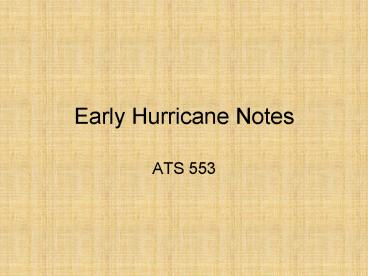Early Hurricane Notes - PowerPoint PPT Presentation
1 / 48
Title:
Early Hurricane Notes
Description:
A discrete system of apparently organized convection maintained for a day or more ... Animals (Antelope, Bear, Cat, Dog...) Adjectives (Aggressive, Blusterly... – PowerPoint PPT presentation
Number of Views:107
Avg rating:3.0/5.0
Title: Early Hurricane Notes
1
Early Hurricane Notes
- ATS 553
2
(No Transcript)
3
Hurricane Classification
- TROPICAL WAVE
- A trough or cyclonic curvature maximum in the
tradewinds
4
Hurricane Classification
- TROPICAL DISTURBANCE
- A discrete system of apparently organized
convection maintained for a day or more
5
Hurricane Classification
- TROPICAL STORM
- A warm core tropical cyclone with closed isobars,
rotary circulation, and winds between 34 and 64
knots. - WHEN THEY GET THEIR NAME
6
Hurricane Classification
- HURRICANE/TYPHOON
- A warm core tropical cyclone with closed isobars,
rotary circulation, and winds of at least 64
knots. - Does not necessarily have an eye, but often does.
7
Characteristics
8
Naming Hurricanes
- In the Atlantic
- A, B, C, D
- Alternate boy-girl
- Rotate through six lists
- Retire names for especially damaging storms
9
(No Transcript)
10
Eastern Pacific
- Very similar scheme as in the Atlantic
11
Western Pacific
- Just uses a long list
- In alphabetical order BY THE COUNTRY THAT
SUBMITTED THE NAME - Names can be retired, too.
12
(No Transcript)
13
(No Transcript)
14
Other Basins
- Use other schemes
- Usually just short lists that they rotate through
as needed
15
Historically
- Prior to WWII, storms were named after the patron
saint of the day. - Post WWII, various schemes
- Phonetic alphabet (alpha, bravo, charlie..)
- Animals (Antelope, Bear, Cat, Dog)
- Adjectives (Aggressive, Blusterly)
- All Female Names starting in the mid 1950s
- Male names started in 1979
16
Tropical Cyclones vs. Midlatitude Cyclones
- Strongest Winds
- MC Jet Stream
- TC Surface
17
Tropical Cyclones vs. Midlatitude Cyclones
- Core Temperature
- MC Cold core (trough)
- TC Warm core (LHR in eyewall, subsidence in eye)
18
Tropical Cyclones vs. Midlatitude Cyclones
- Structure
- MC Asymmetric, fronts
- TC Symmetric, no fronts
19
Tropical Cyclones vs. Midlatitude Cyclones
- Scale
- MC Synoptic scale
- TC Mesoscale in size, synoptic scale in duration
20
(No Transcript)
21
Why Winds Decrease With Height In A Hurricane
- ATS 553
22
(No Transcript)
23
Warm Core Systems
24
Temperature Gradient!
25
From Above
26
From Above
27
From Above
28
What if this were a regular warm front?
- What would the Thermal Wind relationship tell us
about how winds would be changing with respect to
height?
29
What if this were a regular warm front?
- Wind speeds at the surface would be weak.
- Aloft, there would be a Midlatitude Jet Stream!
Winds would be getting more positive with height!
30
What if this were a regular warm front?
Height
0
Wind Speed
31
But This Is NOT a Midlatitude Cyclone
32
But This Is NOT a Midlatitude Cyclone
33
Strong Surface Winds
34
With height, these winds DECREASE due to the
Thermal Wind Relationship!
35
Strong Surface Winds
36
get weaker with height
37
even reverse aloft..
38
to create the upper-level anticyclone!
39
Wind Profile
Height
0
Wind Speed
40
Hurricane Cookbook
- 1. High SSTs (at least 26C)
- Flux of sensible and latent heat
- Hurricanes do NOT seek out warm water
41
Hurricane Cookbook
- 2. Coriolis Force (at least 5 off of the
equator) - Hurricanes are in CYCLOSTROPHIC balance, not
GEOSTROPHIC BALANCE - However, Coriolis Force keeps the winds from just
following directly into the region of low
pressure when it first forms. - Hurricanes dont FORM at the equator.
- Hurricanes dont CROSS the equator!
42
Hurricane Cookbook
- 3. Instability
- Rules out subtropical highs, which are regions of
sinking motion and high stability - KNOW WHY SINKING MOTION IS ASSOCIATED WITH
INCREASED STABILITY!
43
Hurricane Cookbook
- 4. No wind shear
- Redistributes vertical profile of latent heat
release, setting up the wrong circulation
patterns - TUTTTropical Upper Tropospheric Trough
44
TUTT June thru August
45
Hurricane Cookbook
- 5. High relative humidities through midlevels of
the troposphere - Helps reduce the impact of entrainment.
- Individual Cumulus towers are easily destroyed by
entrainment of dry air.
46
Hurricane Cookbook
- 6. An initial disturbance
- Unorganized groups of thunderstorms organize into
tropical storms. - Typically these are West African Squall Lines or
other disturbances in the AEJ.
47
Saffir-Simpson Scale
48
(No Transcript)































